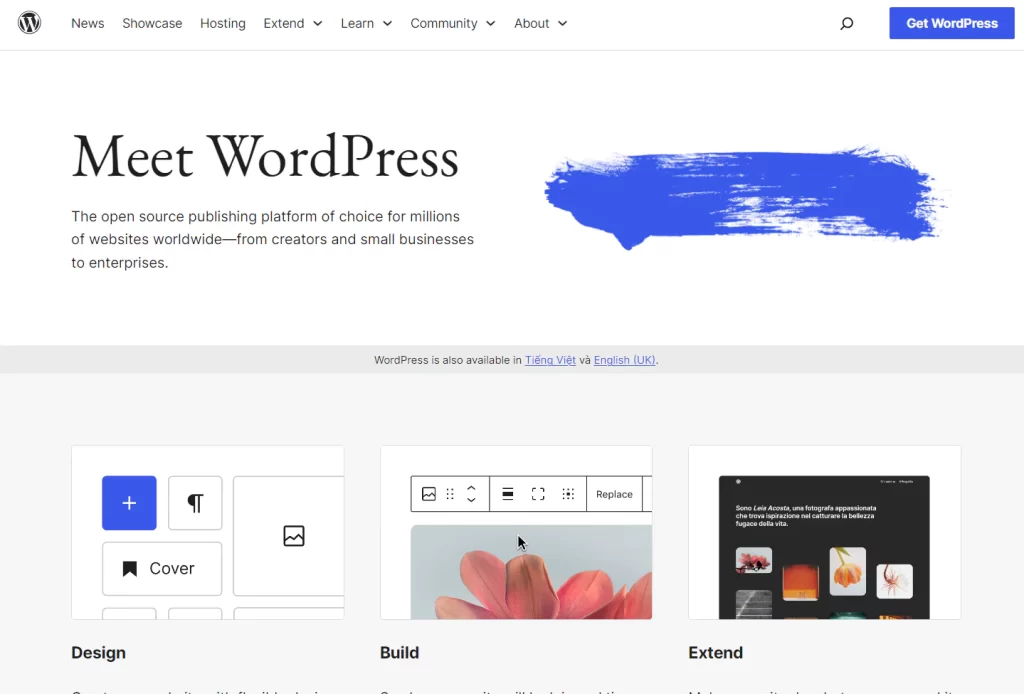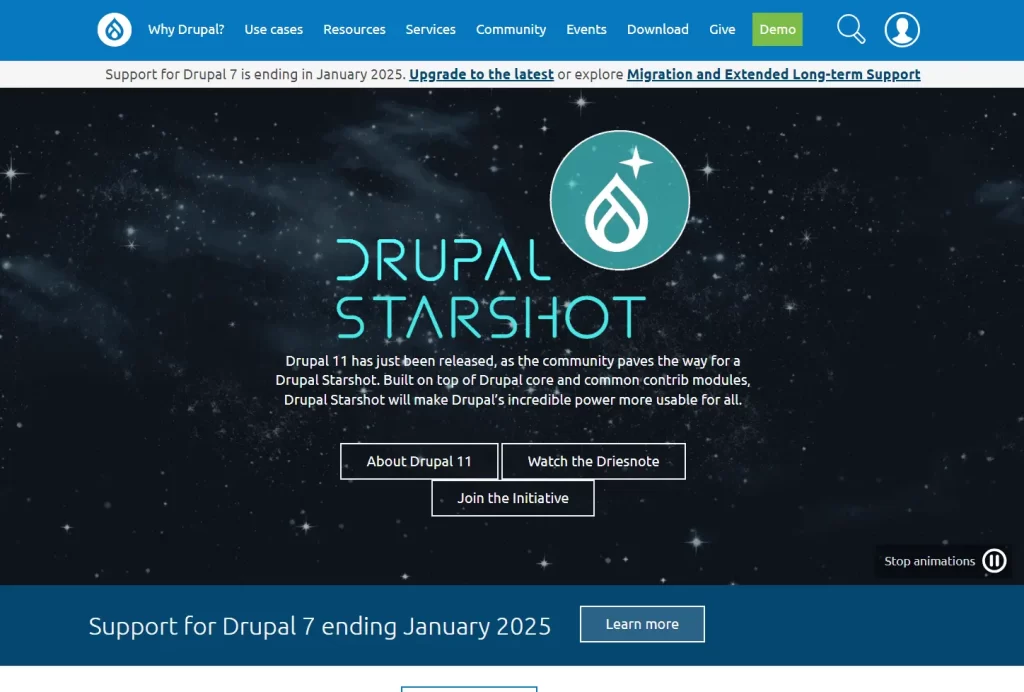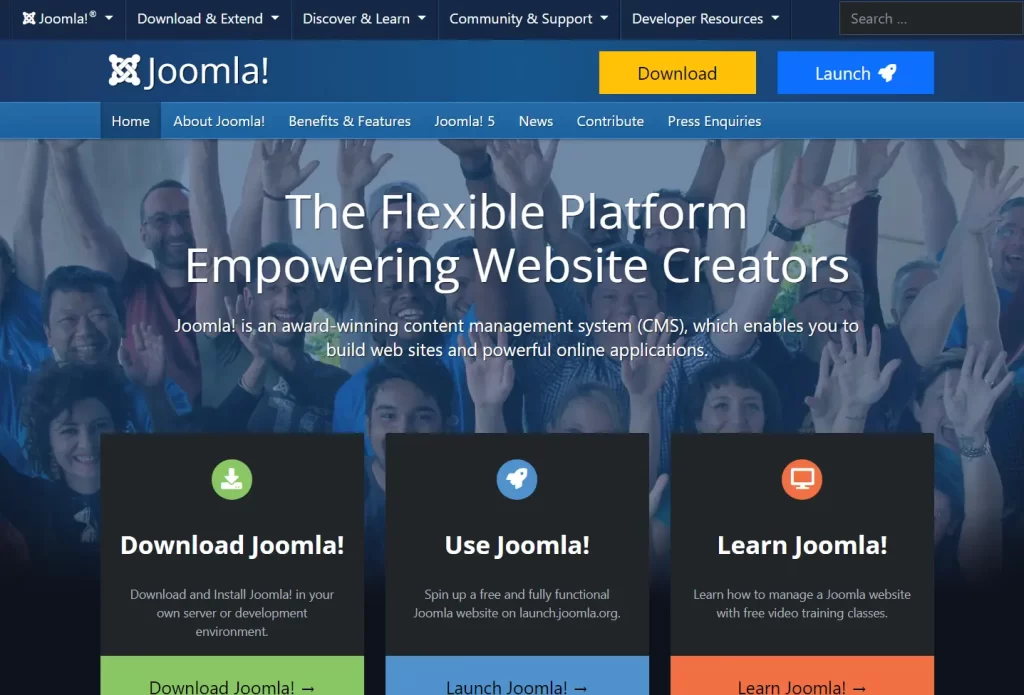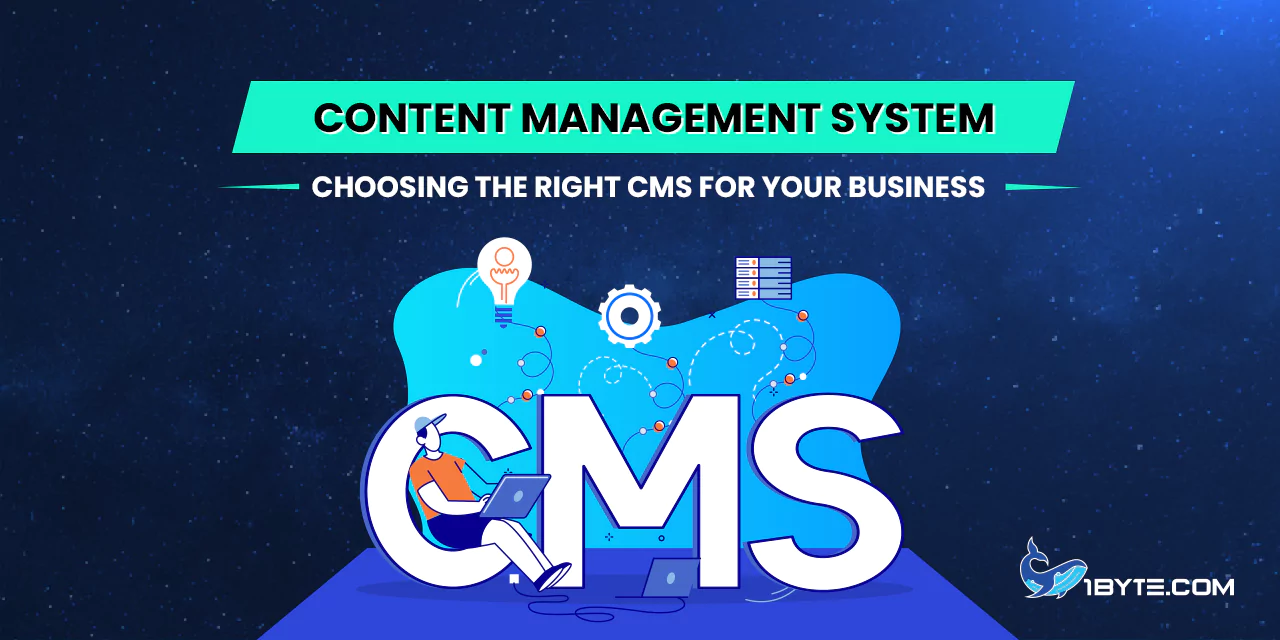- Understanding Content Management Systems (CMS)
- Why Businesses Need a CMS
- Why CMS Platforms Are So Popular
- Benefits of Using a CMS
- Examples of Popular CMS Platforms
- Trends and Innovations in CMS
- Choosing the Right CMS for Your Needs
- 1Byte – Empowering CMS Users Worldwide
- Top 5 CMS Platforms
- Conclusion
Selecting the right content management system (CMS) for your business is a very important decision. It is a decision that determines the future of your online profile. Currently, more than 76 million websites employ a CMS, of which WordPress dominates the market with a 62.8% share as of 2024.
But how does one go about it especially given that the field is filled to the brim with so much competition? To begin with, it is necessary to explain what a CMS is. A CMS stands for Content Management System and it is a tool that assists you in developing content for your website and publishing it on the internet without the need to write a single line of code. It is like having a set of tools to create a great online image, all the tools are in one place and ready to be used.
Now let us illustrate with examples. If you are operating an enterprise level site, then Content Hub could be the way to go. In the case of blogs, WordPress is usually the most popular option. Joomla is excellent for membership sites whereas Drupal is perfect for sites that get a lot of traffic and have lots of data. These are just a few examples of how various CMSs are designed to meet various requirements.
Well, how does one select the right CMS for his/her business? First of all, it is necessary to define what your website requires. The features you want, the level of customization you need, and the amount of money you are willing to spend should be thought of. So, the best CMS for your business is the one that meets your needs and objectives in the most effective way.
Tune in for more details on CMSs where we will offer you the latest statistics, references to useful reports, and examples so that you can make the right decision. Selecting the right CMS is not an easy task, however, with the right information, it becomes a fairly easy task.
Understanding Content Management Systems (CMS)
A Content Management System (CMS) is a software application that facilitates the creation, management, and modification of digital content on a website. It’s the digital hub where you create your site and store all the content you want to publish.

As of 2024, approximately 68.7% of all websites use a CMS. WordPress holds the majority of the CMS market share at 62.8%, followed by Shopify at 6.2%, and Wix at 3.8%. These statistics highlight the growing reliance on CMS platforms for website development.
The benefits of using a CMS are numerous. They include improved content organization, efficient content creation and editing, enhanced collaboration, streamlined publishing, and consistent branding. Furthermore, CMS platforms typically offer a variety of customization options.
Choosing the right CMS for your business involves assessing your organization’s specific needs. Key considerations include ease of use, customization flexibility, SEO-friendliness, budget, security, technical support, and integration with web analytics. It’s important to choose a CMS that aligns with your team’s skill level, offers features that benefit your organization, and can scale as your needs change.
FURTHER READING: |
| 1. Top 5 Best CMS for eCommerce in 2025 |
| 2. The Ultimate Website Migration Guide in 2025 |
| 3. Top 10 Best Website Builders in 2025 |
How a CMS works
A Content Management System (CMS) is a tool that helps in managing, creating and publishing content online. It is more like a content store where many people in a team can create, edit and even publish content.
The CMS works through two key parts. The first one is the content management application (CMA). This is where your team can add and manage content before it goes live on your site. The second component is the content delivery application (CDA). This retrieves the content that is uploaded in the CMA, saves it on the back end and displays it to the viewers.
Another important characteristic of a CMS is that it enables editors to work on the content in real time while they can preview how the content will look when it is published. This feature allows the creators to view websites and apps under construction.
The two core parts of a CMS: Content Management Application (CMA) and Content Delivery Application (CDA)
A Content Management System (CMS) is an effective tool that can be used to manage the content creation, modification and deployment. It consists of two integral components: The two main components of the architecture are the Content Management Application (CMA) and the Content Delivery Application (CDA).
Content Management Application (CMA)
CMA is the front end of a CMS through which content creators can create and edit content without having to code. It is kind of like the dashboard of your CMS where you can type in text, upload images, and even change the format of your website.
For instance, if your CMS is WordPress, then you can create a new blog post by using a simple text editor. This is an easy to use tool in the CMA that allows even non technical users to contribute to the content of the website.
Content Delivery Application (CDA)
The CDA, however, is the working tool that receives the content from the CMA, saves it, and displays it to your website visitors. It is in charge of collecting the content that you have developed and accumulated in the CMA and storing it appropriately and making it easily retrievable by your site visitors.
In other words, the CDA translates the content input into templates and to web format, which allows the visitors to work with it. It is the central component of the CMS mechanism, which takes content from the backend, transforms it according to templates, and delivers it in a format that is understandable for the website visitors.
Combined, the CMA and CDA are the core of any content management system, so you can easily organize your website’s content and deliver it to your audience without any hassle.
Why Businesses Need a CMS

In today’s world where the Internet is a major factor in the economy, a content management system or CMS is not a luxury but a necessity for any business. It’s the backbone of a successful online presence, and here’s why:It’s the backbone of a successful online presence, and here’s why:
- Efficient Content Management: A CMS makes the process of developing and disseminating content for the digital platform easier. Even with no background knowledge in CSS, HTML or coding, businesses can easily upload and edit content through an easy to use interface. This efficiency is very important in the current world that is characterized by the use of technology in almost everything.
- Collaboration and Workflow Enhancement: CMS platforms enable many users to work in the back end of the same tool. This feature helps in coordination of the team members and makes sure all the members understand the project.
- SEO-Friendly: It is important to note that most of the CMS platforms have integrated SEO features. This feature assists companies to ensure that their content is properly indexed by search engines hence increasing its visibility and ranking.
- Customization: There are countless options for customization with CMS platforms. The design and features of the site can also be aligned to the business’s brand.
- Cost-Effective: A CMS saves the business from having to hire a web programmer to design the layout of the website and input new content. This cost-effectiveness is especially significant for small to medium enterprises.
- Real-Time Updates: CMS allows businesses to edit the content of the digital content in real-time. This capability helps in making sure that the content that is being produced is timely and is still useful.
According to the current data, more than 76 million websites rely on a CMS. Thus, more than 900,000 of the 1 million most popular sites have adopted a CMS. WordPress is the most popular CMS with 62.8% of the market share. These figures go to show that more and more businesses are turning to CMS platforms for their operations.
Why CMS Platforms Are So Popular
CMS platforms have rapidly grown in popularity because they solve a fundamental problem: managing a website’s content easily and efficiently. Today, the majority of websites use a CMS. According to the latest surveys, only about 28.8% of websites run without a content management system – meaning roughly 71% do use a CMS of some kind. In fact, the use of CMS has exploded over the past decade. Back in 2013, most websites were hand-coded; nearly 68% of sites had no CMS. By 2025, that figure dropped to 28.9%, indicating a huge shift toward CMS-powered development. In practical terms, almost everything published on the web today, from personal blogs to corporate sites, is mediated by a CMS – the alternative would be to code every page by hand, which is inefficient in comparison.
This popularity is also reflected in the sheer number of CMS options available. There are hundreds of CMS platforms (around 900 known CMS software packages), ranging from simple website builders to enterprise-grade digital experience platforms. Yet, a few major players dominate the landscape, which we’ll discuss shortly. The ubiquity of CMS technology shows that managing content has become a solved problem for most websites – site owners prefer to use a ready-made system rather than reinvent the wheel.
Benefits of Using a CMS
Why choose a CMS over building a site from scratch? Here are some key benefits of content management systems:
- No Coding Required: The best thing about it is that you do not need to be a programmer to use a CMS. The system allows you to make pages, blog posts, and other contents using a simple editor. This enables individuals with no or minimal knowledge of programming to maintain websites, the CMS does the technical grunt work and you do the content.
- Easy Content Editing: The CMS platforms allow easy writing and formatting of the content using a familiar interface (usually similar to MS Word or Google Docs). The dashboard enables you to update text, add pictures or adjust layouts within minutes. This implies that it is easy and quick to update your site without the need to employ a developer to do it every time you want to make a small change.
- Collaboration & Roles: A CMS enables a site to be worked on by several users in an efficient manner. User roles and permissions are built-in such that you can determine who can do what. As an example, authors may be allowed to write articles, editors may approve and publish articles, and administrators may be allowed to manage site settings. This partnership is secure and organized – the content creators cannot break the code or design of the site by mistake, since they have no access to other sections of the site.
- Design Templates: The majority of CMS systems have a number of pre-designed themes/templates that define the appearance of your site. With a new theme you can simply redesign the appearance of your site without altering the content. They are frequently responsive (mobile-friendly) and come with standard features such as navigation menus and contact forms built in. Templates save you an immense amount of design time and guarantee that your site will look professional on every device.
- Extensibility with Plugins: In addition to the core functionality, CMSs usually allow adding functionality through plugins or extensions. Need an image gallery, contact form, SEO tools or e-commerce storefront? There is probably a plugin for it. As an example, WordPress offers more than 70,000 plugins of any kind of feature. You can install a plugin in a few clicks instead of coding new features. This modular system allows you to begin with a basic system and add more features as you require.
- SEO and Marketing Tools: Most CMS have their own SEO features or allow the use of SEO plug-ins. This assists you to optimize your site to be ranked by search engines. It is simple to create custom page titles and meta descriptions, create XML sitemaps, add alt text to images, and create search engine friendly URLs all via the CMS interface. Other CMSs can also incorporate analytics, social media, and other marketing tools, which makes it simpler to market your content.
- Security & Maintenance: Good CMS software is well maintained by their developers or community. They are updated on a regular basis to fix security holes and enhance performance. Also, the CMS ecosystem usually offers security (such as firewalls, spam protection, backups) in the form of a plugin or service. Although no system is risk-free, a popular CMS will have a large community that will fix any problem fast. It is much easier to maintain your site secure and up-to-date when much of it is done by the CMS (e.g. WordPress will remind you of updates or even update minor releases automatically).
- Scalability and Future-Proofing: Just because you start on a CMS, it does not imply that you are relegated to a small site. Most CMS systems are scalable to accommodate large traffic or very large websites. They tend to advocate the introduction of additional servers, caching systems and other improvements as your audience increases. In addition, CMSs are so popular that they are unlikely to become outdated in the nearest future, so you can be sure that popular systems are going to be adjusted to the new trends in web development. As an example, responsive design features were added to CMS when mobile browsing increased, and when new rules of SEO are published, SEO plugins are updated to comply with them. This maintains your site on the best practices in the long run.
In short, a CMS is easy to use, fast and flexible. It allows you to focus on content and strategy rather than low-level web development information. These advantages are the reason why sites using CMS have been multiplying in the web.
Examples of Popular CMS Platforms

The number of CMSs available on the market is great, yet several platforms are prevailing on the market because of their functionality and community. These are some of the most popular CMS, and what they are known to be:
- WordPress: WordPress is the most popular CMS currently. It is an open-source platform initially designed to blog, but currently applied to any type of websites. WordPress is used in approximately 43 percent of all websites on the internet, which is an insane figure, and has a market share of approximately 61 percent of all websites using a CMS. It is popular due to its ease of use, massive collection of plugins/themes, and a large community. WordPress is capable of operating simple personal blogs, company websites, online shops (using such a plugin as WooCommerce), and even large news websites. Examples: WordPress is used to power the official blog of Sweden and websites such as TechCrunch.
- Shopify: Shopify is a commercial (hosted) CMS, which is specifically targeted to e-commerce. It enables people and companies to establish online stores in a short period of time and does everything including product catalog pages to payment processing. The second most popular CMS in terms of usage is Shopify – approximately 4.8 percent of all websites use it. It is one of the leaders among e-commerce websites because of its simplicity of installation and store management tools. Example: Shopify is used by many small retailers and even large brands (such as Gymshark) to run their online stores.
- Wix: Wix is a simple to use web site builder which is also a CMS. It offers a drag-and-drop design interface, and therefore, the user can see his site elements arranged visually. Wix is famous among small business sites, portfolio, and personal websites. It does not involve any technical expertise. Wix has a market share of approximately 3.9 percent of all websites, which makes it another leading player. Its development has been immense over the past years- Wix market presence increased more than 1600 percent in the period of 2015 to 2025 themeisle.com, which shows the need of simple, code-free web-site solutions.
- Squarespace: Squarespace is yet another hosted CMS that is an all-in-one and has elegant designer templates. It is popular among artists, food establishments, and business people who desire a cool professional appearance with little effort. Approximately 2.4 percent of websites in the world are run on Squarespace. Its users like its refined template designs, and features (blogging, e-commerce, etc.) that are out-of-the-box on a stable hosted platform.
- Drupal: Drupal is an open-source CMS that is commonly utilized to create large, complicated sites that require additional custom structure and security. Many government sites, universities and enterprises choose it. Drupal has fewer users in raw numbers (approximately 0.8 percent of all websites), but it has a large niche of sites that need a heavy-duty, flexible CMS. Drupal has robust multi-language capabilities, extensive user permission system, and a modular development framework that allows developers to create custom functionality. Examples: The official site of The White House (as of previous years) and a large number of university sites have been built using Drupal.
Other well-known CMS platforms are Joomla (an earlier open-source CMS that continues to power approximately 1-2 percent of websites), Magento/Adobe Commerce to manage large e-commerce businesses, and new headless CMS services that we will discuss in the next section.)
Both platforms are strong in their own way. The best CMS is a matter of project: WordPress is a very good general-purpose system to use on most websites, Shopify is best suited to online shops, Wix/Squarespace are best suited to quick brochure sites or portfolios, and Drupal is best suited to complex, enterprise situations. The unifying factor is that all these solutions save developers and content creators innumerable hours, by offering prepared systems to handle content.
Trends and Innovations in CMS
The world of content management is constantly evolving. Here are a couple of important trends and recent developments in the CMS space:
- Headless CMS and Omnichannel Content: Traditionally, a CMS not only manages content but also handles how it’s displayed on a website (the “head”, i.e., front-end). In contrast, headless CMS solutions focus solely on content storage and editing, and deliver content via APIs to any front-end or device. This approach is increasingly popular as companies want to reuse content across websites, mobile apps, smart devices, and more. Headless CMS platforms (like Contentful, Strapi, or Sanity) don’t assume a single website front-end – they let you connect your content to multiple channels. Adoption of headless architecture has grown rapidly; a 2024 international survey found 73% of businesses are now utilizing headless in some form, and nearly all others plan to evaluate it within the next year. In short, headless CMS is moving from a niche concept to mainstream, because it offers flexibility to deliver content anywhere. Even WordPress can be used in a headless mode (serving content via its API to a separate front-end), blending the ease of a traditional CMS with the adaptability of a headless system.
- CMS Market Growth: With so many websites and applications relying on content management, it’s no surprise that the CMS industry is big business. The global market for content management software was estimated around $30–31 billion USD in 2024-2025 and is projected to keep growing steadily over the coming years. This growth is driven by the continuous demand for online content and the need for tools to manage that content efficiently. We also see growth in specialized CMS categories (for example, CMS tailored for e-commerce, education, or blogging). Additionally, website builders (like Wix, Squarespace) that cater to small businesses have gained significant market share recently, tapping into users who need simplicity and fast results.
- Integration of AI and Automation: Another emerging trend is the incorporation of artificial intelligence into CMS platforms. Some modern CMS tools now offer AI-assisted content suggestions, automatic image tagging, or smart chatbots that integrate with your content database. For instance, there are plugins for popular CMSs that can analyze your writing for SEO improvements or even generate draft content. While still in early stages, these AI features aim to further simplify content creation and personalization. We can expect future CMS versions to increasingly automate routine tasks (like formatting, SEO checks, or content personalization for different audiences) using machine learning.
- Improved User Experience and Accessibility: As competition between CMS platforms grows, there’s a push to make them even more user-friendly. The rise of block editors (such as the Gutenberg editor in WordPress) and drag-and-drop page builders indicates a trend towards more visual editing experiences. CMS developers are also focusing on accessibility (ensuring sites and editors meet WCAG standards) and localization (supporting multiple languages out-of-the-box) to broaden the usability of their systems.
Overall, the trend is that CMS platforms are becoming more flexible, powerful, and user-centric. Whether it’s decoupling the front-end (headless), adding AI, or simplifying design, the goal is to empower content creators to deliver content faster and to more places. The dominance of a few big CMS players might evolve as new technologies emerge, but the core idea – making content management simple – remains at the heart of every innovation in this space.
Choosing the Right CMS for Your Needs

For beginners and businesses alike, selecting a CMS can seem daunting with so many options available. Here are a few considerations to keep in mind when choosing a content management system:
- Ease of Use: If you are not very technical, you might want to focus on a CMS that has an easy to use interface and a good documentation/community. All-in-one experiences with hosted site builders such as Wix or Squarespace are very smooth. Most people can also use WordPress, and there are myriads of tutorials and plugins that can help you get what you desire without having to code.
- Purpose of the Site: The purpose of your project will play a big role in the CMS selection. A basic blog or informational site may only need a general CMS such as WordPress or a hosted service such as Medium. In the case of an online store, product catalog and shopping cart functionality will be available out-of-the-box on an e-commerce-oriented platform (Shopify, BigCommerce, or WooCommerce on WordPress). In case you require a community forum or social network functionality, you may consider special CMS/forum software (or plugins that provide those features). Ensure that the CMS you choose is suitable to the type of content and functionality you require.
- Customization and Scalability: Think of the extent to which you would like to customize and expand the site. There are quite flexible CMS platforms (e.g., Drupal can be shaped into virtually any kind of site but might need developer assistance). Others sacrifice flexibility in exchange of ease (e.g. Wix is very easy but somewhat limited when you require custom features not provided in its ecosystem). In case you expect to require special functionality or heavy customization, select a platform that has a reputation of being extensible and has an active developer community. And scalability, too, will this CMS be able to support your needs should your site increase 100x in traffic or content? Scaling is possible in many platforms, though hosted solutions may become costly at scale, and self-hosted open-source solutions may require increasing levels of technical management as they scale.
- Budget: Not all CMS software is paid (you can find free and open-source CMS software such as WordPress, Drupal, Joomla), but you will have to pay to host it and you may need to pay to use premium themes/plugins or developer support. There are other proprietary options that have a monthly fee (such as Shopify, Squarespace, or CMS Hub by HubSpot). Figure out the overall price (with any plug-ins or transaction charges (in the case of e-commerce)). A paid solution may be worth it because sometimes it can save time and provide support. Open-source solutions are affordable and may need more do-it-yourself.
- Support and Community: In case you believe that you will require assistance, think about the support. Open-source CMS have communities, forums and lots of guides on the internet, but you may not receive official support unless you employ a developer or consultant. The plans of hosted CMS companies typically include support. Also, make sure that developers are easily available to work on the CMS (popular ones such as WordPress or Drupal have lots of freelancers/agencies that can assist you). An active community may be your savior when you need answers or encounter problems.
- Security Requirements: Simple CMS security (and the use of best practices such as strong passwords and backups) is generally sufficient on personal blogs or small sites. However, when you have a site that deals with sensitive data, you may require a CMS that provides a better security level or adheres to some standards. Enterprise CMS systems may have more in this respect or you may require to install security plugins/services to open-source CMS. You should always maintain your CMS up to date to enjoy the latest security patches.
Taking the time to match your requirements with what a CMS offers will pay off. Remember that you can often start with one platform and migrate later if needed, but it’s best to choose a solid foundation from the beginning. For a first website, many users start with a well-rounded option like WordPress because of its balance of ease, flexibility, and community resources. As you gain experience, you’ll get a better sense of what features matter most for your workflow.
1Byte – Empowering CMS Users Worldwide
At 1Byte, we have extensive experience helping clients get the most out of their chosen CMS. We are proud to be a leading cloud computing and web hosting provider, with data centers located worldwide to ensure ultra-low latency for our customers everywhere. Our mission is to make it seamless for anyone to deploy and manage their websites, whether they’re using WordPress, Drupal, an e-commerce CMS, or any other platform.
Our Services and Expertise

We offer a full spectrum of hosting services tailored to CMS users. For instance, our Managed WordPress Hosting provides a one-click setup, automatic updates, and optimized servers, so that bloggers and businesses can focus on content while we handle the technical details. We also provide Cloud Server solutions where clients can customize their server environment – perfect for running more advanced or custom CMS installations with full control. For startups on a budget, our Shared Hosting plans offer a cost-effective way to host smaller CMS websites without sacrificing performance. In addition, 1Byte assists clients with domain registration, SSL certificates, and even value-added services like SMS marketing integration to help you engage your audience. This range of services means no matter which CMS or digital tools you use, we have a hosting solution to support it.
Why choose 1Byte for your CMS-based site?
First, we bring expertise with world-class standards. Unlike generic global hosts, we operate our own data centers and infrastructure, which gives our clients a unique speed advantage. Our commitment to quality has been recognized by the industry.
Furthermore, at 1Byte we pride ourselves on support and customer success. Our team of over 250 professionals (including certified engineers and experienced support staff) works 24/7 to assist clients. We provide multilingual support to ensure clear communication with our diverse customer base. When you host your CMS with us, you’re not just getting server space; you’re gaining a partner who watches over your infrastructure and helps your website run smoothly. We monitor performance, help with migrations or setup, and proactively advise on security. For example, if a client’s WordPress site suddenly needs to handle a traffic surge, our team can quickly recommend scaling solutions on our cloud platform to prevent any downtime. Our hands-on approach means even clients with minimal IT experience feel confident running their websites – as evidenced by many success stories and testimonials from entrepreneurs who launched their first sites with 1Byte’s help.
Brand Promise
As a leading company in CMS and other essential digital services, we have empowered many organizations to leverage CMS technology effectively. We’ve helped legal firms set up professional sites with Joomla, supported NGOs in deploying Drupal for community portals, and enabled countless bloggers and SMEs to thrive with WordPress and other platforms. Each project, big or small, gets our full attention because our philosophy is that your success is our success. We aren’t just a vendor; we’re a collaborator in our clients’ digital journey. By choosing 1Byte as your hosting provider, you get the peace of mind that your CMS is running on robust infrastructure backed by an award-winning team.
In summary, 1Byte combines global-grade technology (cloud computing, AWS partnership) with insight and support. For anyone looking to launch a website on a CMS, we offer a compelling blend of performance, affordability, and service. We’re excited to continue powering the next generation of websites and content management innovations internationally.
Top 5 CMS Platforms
In the year 2024, organizations understand the importance of a content management system (CMS) in their online strategy. This section reveals the five leading CMS platforms that are ruling the world of web development at the moment.
Every platform has its own benefits and thus, meets different business requirements. From the versatile WordPress to the Shopify that is a powerhouse for e-commerce, these CMS platforms are not just tools, they are doors to the digital world.
It is time to take a closer look at these platforms and reveal their main characteristics, strengths, weaknesses, and the spheres where they can be most effectively applied. This will help you to make the right decision when selecting the right content management system for your business. We will be coming up with detailed features on these platforms, giving you all the current facts and figures to help you make the right decision.
Wix
Wix is one of the youngest players in the content management system market, but it is already making its presence felt with such figures and offering unique solutions. Wix currently hosts approximately 8 million websites as of 2024. This platform is used by 2.8% of all websites, thus making its presence felt in the CMS market share.

One can mention the growth of Wix. Market share growth rate of Wix for the years 2016 to 2023 is 800%. This surge is a testament of the fact that the platform is easy to use and very powerful at the same time.
Wix offers over 300 apps that allow users to improve their websites in various ways. The Wix App Market offers a wide range of apps for different purposes, starting from SEO specialists and ending with e-commerce, so the choice is suitable for any company.
Besides, Wix is not only about figures; it is also about international presence. Wix is used in 190 countries thus showing that it is well accepted all over the world. This wide usage highlights the versatility of the platform to the various markets and the needs of the users.
WordPress.com
In as much as selecting the best content management system for your business is concerned, there is no better option than WordPress. Looking at the list of the analyzed sites, com can be considered as one of the leading contenders. It currently supports more than 43% of all the websites on the internet and is therefore the most popular CMS globally.

WordPress. Not only is com the most popular domain extension, but it is also one of the fastest-growing ones. WordPress has been growing at a rate of 12% per year since 2011 and is widely used in the modern world. This growth has been attributed to the flexibility of the platform, the ease of use and the availability of numerous themes and plugins.
One of the most important advantages of WordPress.com is its scalability. It can effectively handle large traffic websites, online stores, and many other types of sites. This makes it a perfect solution for companies of all sizes and from all fields of activity.
In support of such assertions, there are many large corporations that have adopted WordPress.com for their websites. These are Sony Music, Meta Newsroom and PlayStation. The success stories of their works give real-life examples of what WordPress. This paper aims at establishing the various ways that a business can benefit from having a .com address.
However, it is not only the giants of the market that get a lot of advantages from WordPress.com. Over 500 new WordPress based sites are developed every day and 70 million new posts are published on WordPress. com every month. These numbers demonstrate the popularity of the platform and the engaged audience that is present on it.
As for the security, WordPress.com takes it seriously. Updates are given frequently to make sure that the platform is secure and up to date. This commitment to security is paramount especially for any business that is involved in the processing of sensitive data.
Drupal
Drupal is one of the most suitable and efficient content management systems for businesses. Launched in 2000, over the years it has expanded and is currently the third most used CMS in terms of market share.

The main advantage of Drupal is a large and active community and a large number of available modules, over 42,650, and themes, 2,900. These resources enable organizations to develop their website according to the required purpose. For example, the Chaos module is the most popular Drupal module with more than 11 million downloads; it is a set of APIs and tools that help to improve the customization of a Drupal site.
Nonetheless, its features are powerful and only 1% of all websites on the Internet use Drupal. However, it hosts 15 percent of the world’s 12,000 most popular websites. This means that even though Drupal may not be the most used CMS in the world, it is the most used in building high performance websites.
Another important factor that should be taken into consideration when selecting a CMS is security. In 2014, through a Drupal bug, 12 million websites were targeted. After that, Drupal has advanced in terms of security features to show that it is a safe platform for its users.
Another benefit of Drupal is that it is relatively cheaper to use compared to other content management systems. Although Drupal is an open source, the cost of site development can range up to $40,000. This cost is justified by the flexibility and scalability that Drupal provides to the businesses, which makes it a worthy investment.
Regarding the community, Drupal has a community of 1.3 million members. The active and helpful community is an essential feature for the users and contributes to the constant development of the site.
Shopify
Among the best CMS for your business is Shopify. This comprehensive e-commerce CMS solution is aimed at assisting the merchants in the creation of their online shops. Being an online cloud-based SaaS e-commerce platform, it does not require the owner to worry about the server and its updates, allowing them to solely concentrate on sales.

Shopify is not only a CMS but much more than that. It is an omni-seller commerce platform that has revolutionized the e-commerce industry. Web, mobile, social, marketplaces, physical, pop up stores, Shopify has it all in its back pocket.
Another factor that has made Shopify to be among the best CMS platforms is that it is very easy to use. Shopify has the advantage of enabling the addition of products, modification of inventory, management of orders, and alteration of an online store’s appearance. A clean interface, understandable settings, and an excellent help center reduce the need for support.
Another great aspect is that Shopify allows for integration with other applications. A strong e-commerce platform has many plug-ins and modules to enhance the function of the store. These integrations make e-commerce integration smooth and efficient in terms of operations.
Shopify also has integrated SEO facilities to enhance the text of products, images, and other materials to be easily read by the search engines.
Joomla
When it comes to choosing the right content management system for your business, Joomla is a strong contender. This CMS platform is currently used by 2.4% of all websites whose content management system is known. As of July 2024, Joomla is used by over 1,162,000 live websites, with a significant number of these websites, 644,342 to be precise, registered in Europe.

Joomla is particularly popular among businesses, being the choice for 9% of them. This popularity is likely due to Joomla’s extensive language support, with the platform available in 76 different languages.
The platform’s development benefits from the contributions of approximately 780 volunteers, ensuring it stays up-to-date and responsive to user needs. Joomla’s version 3 is the most widely used, accounting for 83.6% of all Joomla-powered websites.
Leverage 1Byte’s strong cloud computing expertise to boost your business in a big way
1Byte provides complete domain registration services that include dedicated support staff, educated customer care, reasonable costs, as well as a domain price search tool.
Elevate your online security with 1Byte's SSL Service. Unparalleled protection, seamless integration, and peace of mind for your digital journey.
No matter the cloud server package you pick, you can rely on 1Byte for dependability, privacy, security, and a stress-free experience that is essential for successful businesses.
Choosing us as your shared hosting provider allows you to get excellent value for your money while enjoying the same level of quality and functionality as more expensive options.
Through highly flexible programs, 1Byte's cutting-edge cloud hosting gives great solutions to small and medium-sized businesses faster, more securely, and at reduced costs.
Stay ahead of the competition with 1Byte's innovative WordPress hosting services. Our feature-rich plans and unmatched reliability ensure your website stands out and delivers an unforgettable user experience.
As an official AWS Partner, one of our primary responsibilities is to assist businesses in modernizing their operations and make the most of their journeys to the cloud with AWS.
Conclusion
In conclusion, the selection of CMS is a critical step in the development of your enterprise. Choosing a platform is not the only thing; it is about selecting a solution that will help you in achieving your business objectives.
Bear in mind that no two businesses are the same. One cannot compare what is good for the other since everyone is unique in their own way. Hence, it is necessary to identify your particular requirements and assess how the various systems address those requirements.
Do not be carried away by the crowd. Rather, it is necessary to concentrate on the peculiarities that make your business unique and select a CMS that will be able to emphasize these advantages.

